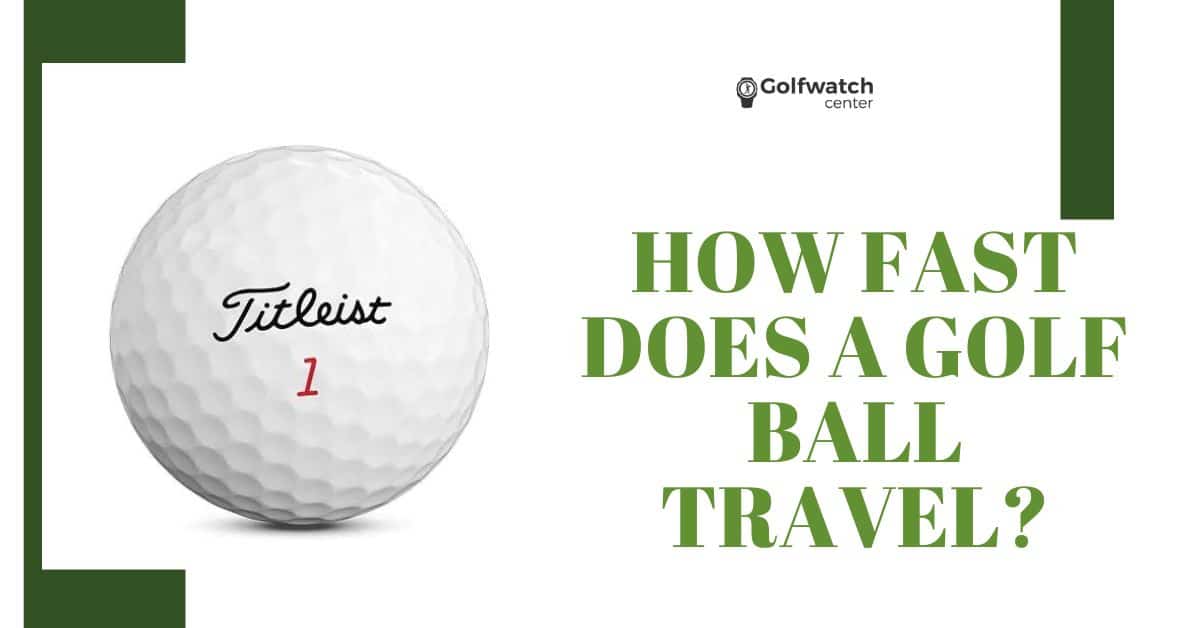As a golf player, you would want to upgrade your technical skills to become successful in it. It is a challenging endeavor, as it demands a combination of various elements such as consistent practice, skillful technique, knowledge, and significant years of hands-on experience. We might find this surprising, as we have mentioned knowledge as well. Yes, it can make a world of difference in your golf skills.
Wondering how? Knowing what’s the relation between distance, speed, and force can make your game more technical and predictable. That’s not enough because there is a lot far beyond it. But presently, we are here to discuss just the factor of speed.
In this article, we will discover how fast does a golf ball travel. In addition, we will cover certain aspects that impact the speed of the ball.
Ready to grasp some knowledge? Let’s get started.
How Fast Does a Golf Ball Travel?
Many factors affect the speed of the ball. For your ease, let’s take a start with the average. According to a survey, the ball hit by professional golfers travels at the speed of 180 miles per hour.
Remember, it’s not a perfect estimate because velocity, force, ball type, and other related factors may change speed. Understanding these factors can help you know how to hit the ball so that it would travel to a certain distance at a certain speed. This predictable skill is hard to achieve as physics has never been easier.
But don’t worry; we will explain these factors in an easy and conceptual way so you can upgrade your skills. Here’s what the factors are and how they affect the ball’s speed.
Type of Golf Ball
Most legal golf balls are crafted to give speed within the legal limits defined by USGA. For instance, if the mass of the ball is greater than 2 ounces, it will result in a faster speed. But the limit USGA sets is 1.620 ounces, so golfers must follow the rules to stay in tournaments.
Fortunately, there are some elements of the ball that you can put to get faster speeds. It includes the ball’s compression level, hardness, and dimple pattern. With the higher level of compression, the ball will travel fast and vice versa.
Moreover, the negative space of dimples results in faster speeds. That’s done by reducing the air resistance. The hardness of the ball provides a fast swing, contributing much to its overall speed.
So it’s better to research all these factors in the ball and choose it as your golf companion.
Applied Force of Golf Club
For a golfer, the swinging technique is a must-have skill. It means how fast you can swing a ball because the higher the applied force, the higher the golf ball’s speed.
Club swinging speed varies from one golf player to another. Most pro golfers have achieved the speed of 180 miles per hour, but it’s their best. The average one can hit the ball with a speed of 150 miles per hour, and that’s also impressive.
It all depends on technique and the swinging speed of the golf club. As the USGA has not restricted the swing limits, golfers can do their best to increase the ball speed.
Type of Golf Club
Every golf gear manufacturer has its way of designing the golf club. Some use tungsten or carbon, whereas others use steel or titanium to craft the club.
The lesser-known fact is that golf clubs differ from each other in the sense of providing speed to the ball. Most pro golfers prefer titanium golf clubs over any other because it creates the maximum possible speed.
The type is not based solely on the material. Its overall size, mass, and surface area of the contact point greatly impact the golf ball’s speed. So do research and select one that is perfect for providing faster speed.
Spot Touched by Golf Club
A golf ball is just big enough that anyone can see it easily. But the area where you can hit the ball to get robust swing shots is very less. This region commonly referred to as the sweet spot is where the magic happens
It’s hard to hit the ball at that particular point. The good idea is to contact the ball as close as possible to the sweet spot. This spot lies on the exact midpoint.
Many golfers, including pros, noticed that the golf club that hits a specific part results in a higher flight and faster speed. If you miss the area, the reduction of distance can be a notable consequence.
Air Resistance
You can not stop nature’s interference in between your way to victory. But once you know how it will interrupt can help you adjust your gameplay accordingly. One such example is air resistance.
This factor can affect the speed and elevation of a golf ball. As air resistance does not change frequently, most golfers will have to face similar conditions on the same day. To manipulate the results in your way, just practice the shots by playing different combinations of swinging speeds and directions.
How Fast Does a Golf Ball Travel With Different Clubs?
As mentioned earlier, each golf club has unique characteristics affecting the ball speed. Here’s a golf ball speed chart with different clubs.
Golf Ball Speed Chart With Different Clubs
This chart includes the golf ball speed to swing speed with different clubs.
| Golf Club | Ball Speed (MPH) | Ball Speed to Swing Speed (MPH) | Ball Speed to Distance (yards) |
| Driver | 167 | 111 | 260 |
| 3 Wood | 158 | 105 | 241 |
| 4 Iron | 137 | 91 | 209 |
| 7 Iron | 120 | 80 | 184 |
| PW | 102 | 68 | 156 |
Note: Each ball speed value given in the above chart is taken as the average of the PGA tour, and then they are classified into swing speed and distance through conversion.
Wondering how would the conversion be possible? You can also do that by simply figuring out some mathematical expressions. Here’s how you can do that:
Golf Ball Speed to Swing Speed Conversion
There’s no hard and fast rule to know the swing speed. What you need is a number, and that’s ball speed. Simply divide the number by 1.5; the answer would be the swing speed. So if your ball is traveling at 160 mph, the maximum swing speed you can expect is 107 mph.
Golf Ball Speed to Distance Conversion
As you know, the golf ball’s swing speed, it’s time to figure out how far it will travel. That’s even easier. You can do that by multiplying the swing speed by 2.3, and the answer in the calculator would be the distance traveled by the ball. For instance, if you swing the ball at 107 mph, the maximum distance the ball can travel is 246 yards.
How to Increase Your Swing Speeds?
The fact remains that the greater the swing speed, the faster the ball would travel while covering more distance. So it’s better to focus on your swinging speed, and all will improve automatically. Here are some tips for getting a better version of yourself.
Improve Your Motion in The Goal
Do you know that your body can’t play the shot until it gets ordered from the brain? If your brain is nervous, the shot you play will travel a distance as short as possible. It is because you didn’t put all your potential into playing the shot. So don’t let nervousness take over you.
Nervousness is a common part of life that makes a home in our mind before special occasions. For a golfer, there is no more special occasion than a tournament. So he would also face it. But to overcome it and relax, you can meditate before the warmup match. It will let your mind take a break from the hard practice routine and take a sigh in the moment of peace. Thus, in the real game, the results will be your way.
Develop Muscular Endurance
If you’re seeking to up your swing speed game, there’s no better move than strethgthen your muscular endurance. It will give you the power to swing with full force.
Do fitness workouts and exercises that include the strengthening of muscles golfers use to swing the ball. These muscles are the glutes, pecs, lats, triceps, biceps, and core. Some related exercises we know are shoulder raises, bench press, pull-ups, leg raises, and abdominal crunches.
Remember not just to force your body to do the workout. If it’s not in the right condition or just fed up with exercises, take a break because golf is not more important than your life.
Use a Light Raft
For most golf pros and average golfers, playing with a lightweight shaft can help increase the speed without sacrificing the accuracy to hit the sweet spot.
Don’t go too light, as it can really cause a significant reduction in your swing speed. It has a deep relation with the fact that muscle activation is reduced, resulting in a decrease in swing speed.
So what raft should you purchase? Well, it is based on individual preferences that cater to their weight, height, etc.
Shift to the Longer Club
While it’s true that an increase in the inch of your club can increase your swing speed by one mph, the quality of the shot is also a must part.
A short club provides more control and accuracy than a longer one, but the swing speed is lower. The best thing you can do is to make an increase of an inch or two inches in your golf club. It will only affect your control and accuracy a little and will also increase your swinging speed.
Improve Your Grip
Two parts of the grip result in a better swing speed: pressure and handle.
You can make handling better by gripping your club in such a way that it is neither too tight nor too light. An extra tightly gripped club increases tension in your body, reducing muscle activation. In contrast, you can not get full control of the club through a swing with a light or loose grip.
The world’s pro golfers tend to use a tight and strong grip because it enables a draw shot shape, which is better for driving longer shots.
Frequently Asked Questions – (FAQs)
Conclusion
We hope that your query: ‘how fast does a golf ball travel’ has been cleared now.
The overall speed of the ball has a few different factors that have a huge impact on it. Some of which we can figure out and improve, and others are not in our hands. However, there are elements, such as your muscular strength, club head speed, and power-hitting ability to contact the center of the golf ball, that you can consider to improve your golf skills.
- Cut Golf Balls Review: Expert’s Verdict - December 10, 2023
- Do Golf Balls Actually Go Worn Out? - October 12, 2023
- What Do The Numbers on Golf Balls Mean? A Look From an In-Depth Perspective - March 10, 2023

